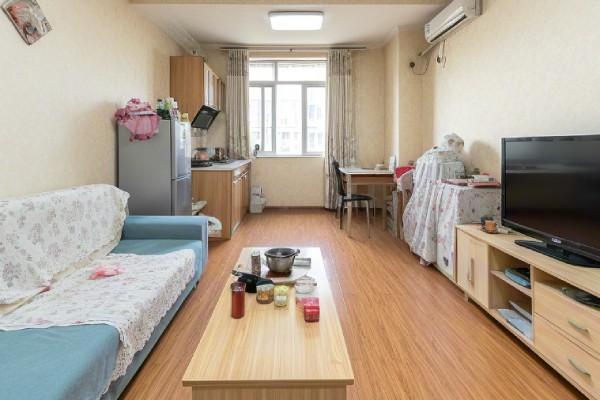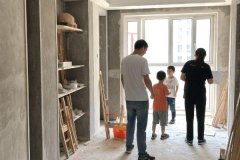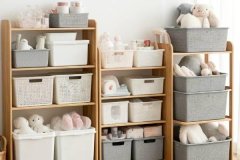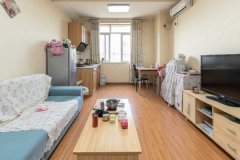How to make a small apartment work for a family
Making a small apartment work for a family requires thoughtful planning and creativity to maximize space while maintaining comfort and functionality. Here are some key strategies to make the most of a small living space:

1. Declutter and Prioritize Essentials
- Minimalism is key: The less clutter, the more spacious your apartment will feel. Start by purging items that are no longer needed or used regularly.
- Focus on essentials: Identify which items are most important to your family’s lifestyle, and ensure they are easily accessible. For example, in a small apartment, multifunctional furniture can replace multiple standalone items.
2. Use Multi-Functional Furniture
- Convertible furniture: Opt for pieces that serve more than one function. For example, a sofa that turns into a bed, or a coffee table that doubles as storage.
- Foldable and stackable options: Invest in foldable dining tables, chairs, and wall-mounted desks to save space when they’re not in use.
- Storage beds: Beds with built-in drawers or lofted designs provide extra storage for linens, clothing, or toys.
3. Utilize Vertical Space
- High shelving and cabinets: Use wall-mounted shelves, tall bookshelves, and cabinets that extend up to the ceiling to store items and keep the floor clear.
- Hooks and pegboards: Install hooks or pegboards on walls to store everyday items like bags, hats, or kitchen utensils, which keeps them accessible without taking up precious counter space.
4. Create Zones for Different Activities
- Define areas: Even in a small space, it’s important to create separate zones for different activities (e.g., sleeping, dining, and working). Use rugs, curtains, or furniture placement to create boundaries.
- Use room dividers: Folding screens or open shelving can act as room dividers, creating distinct spaces for family members to engage in various activities without feeling cramped.
5. Maximize Natural Light and Use Light Colors
- Natural light: Keep windows unblocked and use sheer curtains or blinds that let in as much natural light as possible. This will make the space feel bigger and airier.
- Light colors: Opt for light and neutral colors for walls, furniture, and decor. Whites, light grays, and pastel tones can help create the illusion of more space.
6. Incorporate Smart Storage Solutions
- Hidden storage: Look for opportunities to incorporate hidden storage in unexpected places, like under the stairs or inside ottomans and benches.
- Under-bed storage: Utilize the space beneath the bed for storage boxes, bins, or even a trundle bed if you have children.
7. Design with Flexibility in Mind
- Adaptable layouts: Furniture should be easy to move or adjust according to your family's needs. For instance, modular sofas that can be rearranged can accommodate different group sizes or activities.
- Portable items: Choose furniture that’s lightweight or on wheels, so you can shift it around depending on the situation (e.g., an extra dining table or work station for the kids).
8. Get Creative with Bedrooms
- Shared rooms: For families with multiple children, consider having them share a room. Bunk beds or lofted beds can free up floor space for play areas or desks.
- Wall-mounted desks or fold-down beds: These space-saving features allow the room to transform from a sleeping area to a functional workspace.
9. Personalize Without Overcrowding
- Create a cozy ambiance: Personal touches like family photos, artwork, or a favorite rug can make a small space feel homier without overcrowding.
- Go vertical with decor: Instead of taking up floor space with large items, use vertical space for wall art, plants, or floating shelves.
10. Involve the Family in Organization
- Delegate tasks: Keep everyone in the family involved in organizing and maintaining the space. A family that works together to keep things tidy will enjoy their small apartment more.
- Create family-specific zones: Designate spaces for kids' toys, homework, or hobbies so that they can easily store and retrieve their belongings.
By blending smart storage, flexible furniture, and functional design with your family’s needs, even the smallest apartment can feel spacious, organized, and welcoming for everyone.
Living in a small apartment with three kids can present unique challenges, but with the right strategies, it’s entirely possible to create a functional and comfortable home for the whole family. Here are some tips to make the most out of your small living space while keeping everyone happy and organized:
1. Maximize Vertical Space
- Bunk Beds & Lofted Beds: Bunk beds are a game-changer in small spaces, providing extra sleeping area while freeing up floor space. If your kids are older, lofted beds can work too, giving space beneath them for desks, storage, or play areas.
- Wall-Mounted Storage: Utilize high shelves, wall-mounted racks, and pegboards to store toys, books, and other items out of reach but still accessible. This helps to keep the floor clear, which is crucial for a small space with active children.
- Hanging Baskets: Install hanging baskets or nets for toys or stuffed animals that would otherwise clutter up the floor.
2. Establish Multi-Functional Zones
- Shared Play Areas: In a small apartment, designating a shared play area can help keep things organized. A section of the living room or hallway can be transformed into a play area with mats, toy organizers, and baskets to store everything when not in use.
- Study Zones: Create designated zones for studying or homework. Even if you don’t have a separate room for each child, consider using corner desks or fold-out tables that can easily be tucked away when not needed.
- Flexible Living Spaces: Furniture that can serve multiple purposes—like a sofa that turns into a bed or a coffee table with built-in storage—can help you adapt the space to your family’s changing needs.
3. Storage Solutions to the Rescue
- Under-Bed Storage: Use storage boxes, bins, or drawers under the beds to store clothes, toys, or books. This area can often be overlooked, but it’s a valuable space-saving solution.
- Stackable Bins and Toy Organizers: Invest in clear, stackable bins or cubby organizers for toys, books, and other small items. Labeling them helps kids easily find what they need and teaches them to clean up after themselves.
- Clothes Storage: In a small apartment, closet space is often limited. Use over-the-door organizers, hooks, or even wall-mounted racks to keep clothes and accessories tidy and easily accessible.
4. Keep Bedroom Design Simple and Functional
- Shared Bedrooms: If your kids are sharing a room, make sure each child has their own space. Personalize their areas with their favorite colors, bedding, and small decor items. Bunk beds or a combination of lofted and trundle beds can help maximize floor space for play or storage.
- Use Modular Furniture: Modular furniture that can be rearranged as your kids grow is a smart choice. Consider a dresser that doubles as a changing table, or modular shelves that can be expanded as your child’s needs change.
5. Routine and Organization
- Daily Cleaning Routine: Establishing a daily cleaning routine is essential in a small apartment. With three kids, messes can accumulate quickly. Get the kids involved in tidying up by assigning small tasks according to their ages—such as putting away toys or making the bed.
- Declutter Regularly: Every few months, do a declutter session with your kids. Donate toys, clothes, and items that are no longer in use. Keeping only the essentials will help your small space feel more manageable.
6. Use Creative and Adjustable Furniture
- Convertible Furniture: Look for furniture that serves multiple purposes. A fold-out table can serve as a workspace for the kids to draw or do homework, but when not in use, it can be folded away to open up the living space.
- Furniture on Wheels: Invest in furniture on wheels that can be easily moved to change the layout depending on the need, such as extra seating for playdates or moving a desk to the kids’ room for more quiet time.
7. Incorporate Smart Technology
- Toy Rotation System: To avoid overwhelming the kids with too many toys, try a toy rotation system. Store some toys in bins and rotate them every few weeks to keep things fresh and minimize clutter.
- Space-Saving Appliances: If you have space restrictions in the kitchen or laundry area, invest in compact appliances like stackable washers and dryers, or multi-functional cooking gadgets that take up less room but still meet your family’s needs.
8. Create Private Spaces for Each Kid
- Personal Corners: If space is tight, designate a “personal corner” for each child. This can be a small nook with a beanbag chair or a desk where they can read, draw, or relax without feeling crowded by their siblings.
- Curtain Partitions: Installing curtain rods to divide the room can create a sense of personal space for each child, especially in shared rooms. This gives them a small area to call their own, even within a larger shared environment.
9. Embrace Flexibility and Adaptability
- Adapt as Your Kids Grow: As your children get older, their needs and routines will change. A space that worked when they were toddlers may need to evolve into a more grown-up layout for schoolwork, socializing, or hobbies. Being flexible and open to adjusting your living space regularly can help ensure it continues to work for your family.
- Involve the Kids in Design: Let your children have a say in the design of their space. Giving them some ownership in the layout or decoration can help them feel more comfortable and invested in maintaining the space.
10. Make the Most of Outdoor Space
- Utilize a Balcony or Patio: If you have access to outdoor space like a balcony or small patio, transform it into a mini playground or outdoor lounge area. A small table, some outdoor seating, and a few toys can make a huge difference in giving your kids space to play and unwind.
By being strategic and creative with your space, a small apartment can comfortably accommodate three kids without feeling overcrowded. The key is to prioritize organization, adaptability, and maximizing the functionality of every square foot. With the right mindset and some careful planning, your family can enjoy a cozy, efficient, and happy living environment.









